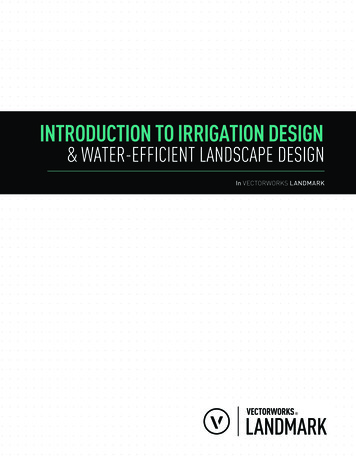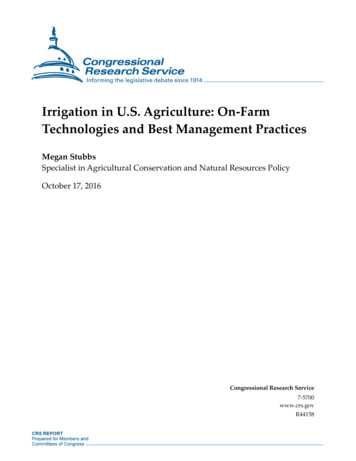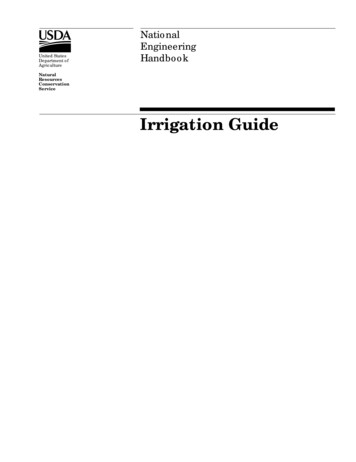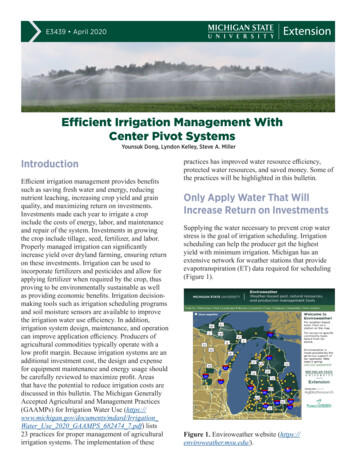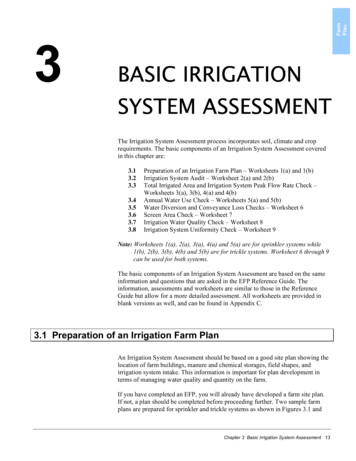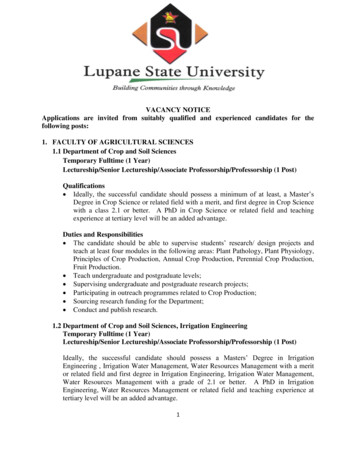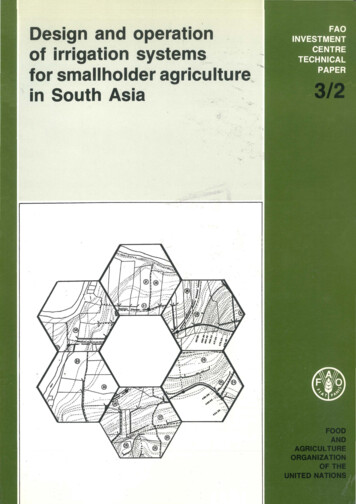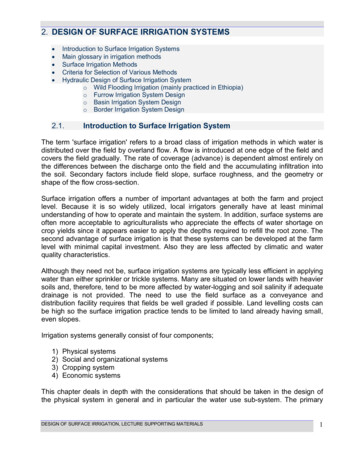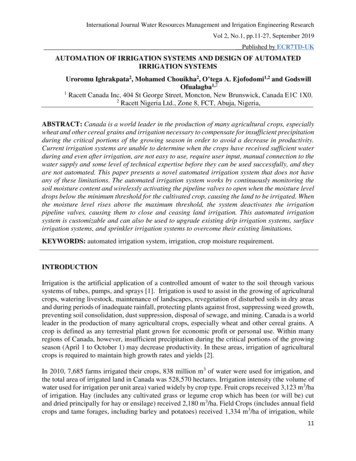
Transcription
International Journal Water Resources Management and Irrigation Engineering ResearchVol 2, No.1, pp.11-27, September 2019Published by ECR7TD-UKAUTOMATION OF IRRIGATION SYSTEMS AND DESIGN OF AUTOMATEDIRRIGATION SYSTEMSUroromu Ighrakpata2, Mohamed Chouikha2, O’tega A. Ejofodomi1,2 and GodswillOfualagba1,21Racett Canada Inc, 404 St George Street, Moncton, New Brunswick, Canada E1C 1X0.2Racett Nigeria Ltd., Zone 8, FCT, Abuja, Nigeria,ABSTRACT: Canada is a world leader in the production of many agricultural crops, especiallywheat and other cereal grains and irrigation necessary to compensate for insufficient precipitationduring the critical portions of the growing season in order to avoid a decrease in productivity.Current irrigation systems are unable to determine when the crops have received sufficient waterduring and even after irrigation, are not easy to use, require user input, manual connection to thewater supply and some level of technical expertise before they can be used successfully, and theyare not automated. This paper presents a novel automated irrigation system that does not haveany of these limitations. The automated irrigation system works by continuously monitoring thesoil moisture content and wirelessly activating the pipeline valves to open when the moisture leveldrops below the minimum threshold for the cultivated crop, causing the land to be irrigated. Whenthe moisture level rises above the maximum threshold, the system deactivates the irrigationpipeline valves, causing them to close and ceasing land irrigation. This automated irrigationsystem is customizable and can also be used to upgrade existing drip irrigation systems, surfaceirrigation systems, and sprinkler irrigation systems to overcome their existing limitations.KEYWORDS: automated irrigation system, irrigation, crop moisture requirement.INTRODUCTIONIrrigation is the artificial application of a controlled amount of water to the soil through varioussystems of tubes, pumps, and sprays [1]. Irrigation is used to assist in the growing of agriculturalcrops, watering livestock, maintenance of landscapes, revegetation of disturbed soils in dry areasand during periods of inadequate rainfall, protecting plants against frost, suppressing weed growth,preventing soil consolidation, dust suppression, disposal of sewage, and mining. Canada is a worldleader in the production of many agricultural crops, especially wheat and other cereal grains. Acrop is defined as any terrestrial plant grown for economic profit or personal use. Within manyregions of Canada, however, insufficient precipitation during the critical portions of the growingseason (April 1 to October 1) may decrease productivity. In these areas, irrigation of agriculturalcrops is required to maintain high growth rates and yields [2].In 2010, 7,685 farms irrigated their crops, 838 million m3 of water were used for irrigation, andthe total area of irrigated land in Canada was 528,570 hectares. Irrigation intensity (the volume ofwater used for irrigation per unit area) varied widely by crop type. Fruit crops received 3,123 m3/haof irrigation. Hay (includes any cultivated grass or legume crop which has been (or will be) cutand dried principally for hay or ensilage) received 2,180 m3/ha. Field Crops (includes annual fieldcrops and tame forages, including barley and potatoes) received 1,334 m3/ha of irrigation, while11
International Journal Water Resources Management and Irrigation Engineering ResearchVol 2, No.1, pp.11-27, September 2019Published by ECR7TD-UKVegetable crops received only 867 m3/ha of irrigation [3]. Some common sources of irrigationwater include groundwater, springs, wells, rivers, lakes, reservoirs, and other sources such astreated wastewater or desalinated water [1]. In Canada, 3,260 farms obtained at least some of theirwater for irrigation from on-farm lakes and rivers while 1,555 drew at least some of their waterfrom an underground well and 3,705 farms procured at least some of their irrigation water fromoff-farm sources (ranging from tap water to provincial water sources such as irrigation districts)[3].There are various types of irrigation techniques, depending on how the water from the source isdistributed within the field. Typically, the goal is to supply the entire field uniformly with water,so that each plant has the amount of water it needs, neither too much nor too little. Four commontypes of irrigation are surface or flood irrigation, localized irrigation, Drip or micro irrigation andsprinkler irrigation. For surface irrigation, water is distributed over and across land by gravitywithout the use of mechanical pumps. The field water efficiency of surface irrigation is typicallylower than other forms of irrigation but has the potential for efficiencies in the range of 70% 90%. For localized irrigation, the water is distributed under low pressure through a piped networkin a pre-determined pattern and applied to each plant or adjacent to it. For drip irrigation, drops ofwater are delivered at or near the root of the plants to minimize evaporation and runoff. The fieldwater efficiency of drip irrigation is typically in the range of 80 to 90 percent. For sprinklerirrigation, the water is piped to one or more central locations within the field and distributed in ahigh-velocity, high-volume spray by overhead high-pressure sprinklers or guns that may or maynot be on moving platforms. In 2010, sprinkler irrigation was by far the most popular irrigation inCanada, with it being used on just over 6,000 farms, while 1,540 and 1,480 farms used surfaceirrigation and drip irrigation respectively. One reason for the popularity of sprinkler irrigation isthat it is well suited for irrigating large areas. It is the most common irrigation method for all croptypes [1,3].There are several types of irrigation systems currently used in the agriculture industry and otherindustries. A system utilizing sprinklers, sprays, or guns mounted overhead on permanentlyinstalled risers is often referred to as a solid-set irrigation system. Higher pressure sprinklers thatrotate are called rotors and are driven by a ball drive, gear drive, or impact mechanism. Rotors canbe designed to rotate in a full or partial circle. Guns are similar to rotors, except that they generallyoperate at very high pressures of 40 to 130 lbf/in² (275 to 900 kPa) and flows of 50 to 1200 USgal/min (3 to 76 L/s), usually with nozzle diameters in the range of 0.5 to 1.9 inches (10 to50 mm). Every rotor has its own flow, wetting diameter, spray radius and trajectory. An exampleof a solid-set irrigation system is the Netafim MegaNet Sprinkler and Netafim PolyNetPolyethelyne Pipe shown in Figure 1. The trajectory angles range from 15-240 and the flow rateranges from 200-750 L/H. Each sprinkler is perfectly balanced with two equal water jets, can beinstalled on solid sets or removable field stands, and distributes water uniformly [4].12
International Journal Water Resources Management and Irrigation Engineering ResearchVol 2, No.1, pp.11-27, September 2019Published by ECR7TD-UKPumping e 1. NetaFim MegaNet Sprinkler System [4] (a) Pumping Mechanism with Netafim PolyNetPolyethelyne Pipe (b) Polyethyelyne Pipe connected to Stand and Sprinkler (c) 1800 spraycoverage with NetaFim Sprinkler (d) 3600 spray coverage with NetaFim Sprinkler (e) NetaFimSprinkler irrigating Field Crops (f) NetaFim Sprinkler irrigating vegetable crops.Sprinklers can also be mounted on moving platforms connected to the water source by a hose.Automatically moving wheeled systems known as traveling sprinklers may irrigate areas such assmall farms, sports fields, parks, and pastures unattended. Most of these utilize a length ofpolyethylene tubing wound on a steel drum. As the tubing is wound on the drum powered by theirrigation water or a small gas engine, the sprinkler is pulled across the field. When the sprinklerarrives back at the reel the system shuts off. This type of system is known to most people as a"waterreel" traveling irrigation sprinkler and they are used extensively for dust suppression,irrigation, and land application of waste water. An example of a current waterreel travelingirrigation system is the CADMAN Mini Traveler (see Figure 2).13
International Journal Water Resources Management and Irrigation Engineering ResearchVol 2, No.1, pp.11-27, September 2019Published by ECR7TD-UKSprinklerSprinklerCartReel/TubingWater Source(a)(b)(c)Figure 2. CADMAN Mini Traveler [5] (a) Mini Traveler with Labeled parts (b) Mini Travelerpowered by irrigation water source (c) Mini Traveler irrigating field crop.Drip irrigation offers several advantages, including strong root development, no evaporation orrun off of water, inexpensive and easy installation, and ability to be installed to a basic hose faucetwith no need for direct connection to water lines. A drip irrigation system consists of a "head" anda distribution network. The head of the system is composed of the water source, pump, filtersystem, pressure regulator and necessary pressure gauges. It may also include a water meter orelectronic controller. The distribution network includes the mainline and laterals or dripper lineslocated down the plant rows [6]. An example of a Drip irrigation system is the Netafim TechlineCV Drip Line (see Figure 3).14
International Journal Water Resources Management and Irrigation Engineering ResearchVol 2, No.1, pp.11-27, September 2019Published by ECR7TD-UKFigure 3. NetaFim Techline CV Drip Line System with four main components: Water sourceconnection , supply and exhaust headers (Poly Tubing supply line), Netafim Drip Line, and amanual flush valve located at furthest point from water source and lowest vertical point of thesystem [7].There are several limitations inherently in current irrigation systems used today. Most of thesesystems are not able to detect when the crops require moisture or water. It is left to the farmers todecide when the crops need to be watered, and their knowledge and experience in determining thiscrucial factor affecting optimum crop productivity varies. Rigorous scientific experiments havenot yet been conducted to ascertain how much water crops need for optimum germination andgrowth. While it is already known that different crops require different amounts of water, thevolume of water required by each crop has not been determined experimentally. The currentirrigation systems are unable to determine when the crops have received sufficient water duringand even after irrigation. Most farmers simply estimate the volume of water tow be dispersed ordistributed during irrigation, but they are unable to determine if and when their crops have receivedsufficient water. Over–irrigation of crops also has adverse effects on some crops, just as inadequatewater also has negative effects on optimum crop productivity.Another limitation of irrigation systems is that they are not automated. They still require user inputbefore they are able to successfully irrigate the land. And this has to be done every single time theland needs to be irrigated. Moreover, these systems are not easy to use. Most of them require the15
International Journal Water Resources Management and Irrigation Engineering ResearchVol 2, No.1, pp.11-27, September 2019Published by ECR7TD-UKuser to have some level of technical expertise before they can be utilized to successfully irrigatecrops. The sprinkler system and the waterreel traveling system discussed above, possess somelevel of automation, but they both require the user to have some detailed knowledge and expertiseabout the system and how to use them to properly irrigate the land. Many of these irrigationsystems also require manual connection to the water supply, and in most cases, require the user tomanually turn on the water supply before irrigation can commence. The irrigation systemscurrently in use today are not able to automatically vary the volume of water supplied to a landwith multi-cropping. So if a farmer has a land in which he/she has planted different crops, witheach crop requiring different volumes of water, these irrigation systems are unable to automaticallyadjust the volume of water supplied to each land section containing a specific crop.There are many reasons why agricultural process have not yet been fully automated. One of themajor reason is that a lot of people have the wrong perception of the agriculture industry. Mostpeople have a backward view of agriculture and their vision of the industry is some form of annualcropping with a lot of physically intensive labor and they fail to see the potential satisfying careerscurrently available in the industry. As a result, a lot of engineers, who are required and vital forthe automation of the agriculture industry, tend to steer away from the industry and go in to moretechnologically advanced industries. This is one of the key reasons why irrigation systems are notyet fully automated. However, automation of the agriculture industry is vital because this industryprovides the food necessary for sustenance of all mankind. Another reason my agriculturalprocesses have not yet been fully automated is that there is still not enough interaction andcollaboration with technologically savvy industries on mutually beneficial projects. There are fewpublications in scientific literature discussing innovative technological products and applicationsfor the agriculture industry.This paper presents a novel automated irrigation system that does not have any of the limitationsdiscussed above. Soil moisture content is automatically measured every few seconds usingmoisture sensors. If the moisture in the soil falls below a minimum threshold for the agriculturalcrop in the land, the system sends a wireless message to the valves in the irrigation pipelines,including the valve controlling access to the main water source, causing the power supply to thevalves to be altered, opening them and allowing water to flow into the land for crop irrigation. Soilmoisture is continuously measured throughout the entire irrigation process. When the moisturelevel in the soil rises above a maximum threshold for the crop, the system sends another wirelessmessage to the valves in the irrigation pipelines, altering the power supply to the valves to shutthem and cease land irrigation. This automated irrigation system can also be used to upgradeexisting drip irrigation systems, surface irrigation systems, and sprinkler irrigation systems toenable them overcome all the limitations they inherently possess.MATERIALS AND METHODSMATERIALSi. SensorsThese are the set of sensors that are used to determine when the automated irrigation system needsto be turned on. A variety of factors can be taken into consideration when determining that theautomated irrigation system needs to be switched on, depending on the application of the system.16
International Journal Water Resources Management and Irrigation Engineering ResearchVol 2, No.1, pp.11-27, September 2019Published by ECR7TD-UKFor water irrigation, the amount of moisture in the soil will be the primary measurement used indetermining the threshold for switching on the system, as well as the humidity. For frost protection,the temperature of the soil surface may be the criteria needed in determining when the systemneeds to be switched on. The automated irrigation system can also be used to ensure livestock havea continuous supply of fresh drinking water. For this particular case, a water level sensor will beneeded to determine when the level of water in the drinking trough has fallen below a minimumlevel. Some of the sensors used in the automated irrigation system are shown in Figure 4.(a)(b)(c)Figure 4. Sensors used in Automated Irrigation System [8] (a) Moisture Level Sensor (b) Humidityand Temperature Sensor (c) Liquid Level Sensorii.Development BoardA development board will be required for the automated irrigation system to be able toautonomously detect the environmental data necessary to determine when land irrigation shouldcommence or cease. The development board used in this system is the Arudnio Mega.Figure 5. Arduino Mega [8]iii.XBeeXBee Pro 900HP wireless modules are used to establish wireless communication between themonitoring unit of the automated irrigation system and the valves in the irrigation pipelines. TheXBee Module is shown in Figure 6a. It is mounted on the Arduino Mega using an XBee Shield17
International Journal Water Resources Management and Irrigation Engineering ResearchVol 2, No.1, pp.11-27, September 2019Published by ECR7TD-UKshown in Figure 6b. The mounted XBee is shown in Figure 6c. With a 2.1 dB antenna, this modulecan establish a wireless connection between the monitoring unit and the pipeline valves up to adistance of 15.5 km. With a high gain antenna, this distance increases to 45 km. This wirelessconnection is used to instruct the valves when to open in order to commence land irrigation, andwhen to close in order to cease land irrigation.(a)(b)(c)Figure. 6. Xbee Modlue [8] (a) XBee Pro 900HP Module (b) XBee Shield (C) XBee stacked onXBee Shield Stacked and Arduino.iv.Irrigation PipesThere are several types of pipes used for irrigation. The most common is aluminum irrigation pipes(see Figure 7). The diameter of the pipes selected for land irrigation depends on the availabilityof the water source and the size of the land to be irrigated.(a)(b)Figure. 7. Irrigation Pipes (a) [9] Flexible Polyethylene pipeline for drip irrigation systems (b)8” Aluminum Irrigation Pipes [10].18
International Journal Water Resources Management and Irrigation Engineering ResearchVol 2, No.1, pp.11-27, September 2019Published by ECR7TD-UKv.Irrigation Pipeline ValvesIrrigation valves are placed at strategic locations within irrigation pipes to control the flow ofwater. By closing or opening these valves, the flow of water to the land can be turned off or on.There are valves available for the different types of irrigation systems (see Figure 8). They usuallyrequire a power supply of 12 V or 24 V. The power connection for the valves can be connected tothe Arduino mega using relays to automatically alter the power supply to the valves, causing it toeither close or open.(a)(b)Fig. 8. Irrigation Pipeline Valves [11].vi.12V and 24 V RelaysRelays are electrical switches used to establish or break an electrical connection. 12 V and 24 Vrelays are used in the automated irrigation system to connect and control the power supply to theirrigation pipeline valves using the Arduino Mega.(a)(b)Figure. 9. Relays [8] (a) 12 V Relay (b) 24 V Relay [11]vii.Irrigation Water Pump19
International Journal Water Resources Management and Irrigation Engineering ResearchVol 2, No.1, pp.11-27, September 2019Published by ECR7TD-UKA water pump is required in order to provide enough force to move the water from the water sourceto the land to be irrigated. This is usually achieved by connecting a water pump to water sourceand the irrigation pipes.Figure 10. Irrigation Water Pump [7]METHODSThe automated irrigation system automatically and continuously measures the moisture level inthe soil using a monitoring unit that comprises of several sensors, an Arduino Mega, XBee Shield,and XBee Pro Module. It also measures the temperature and humidity. Each valve in the irrigationpipeline is fitted with a control unit consisting of an Arduino Mega, XBee Shield, XBee ProModule and a Relay to electrically control its power supply using the Arduino Mega. The waterpump at the water source is also fitted with a control unit. When the moisture level drops below acertain threshold, the system sends a wireless message to the water pump and the pipeline valvesof the irrigation system. Once these valves receive the message, the power supply to the waterpump and valves are altered to activate the pump and open the valves, causing water to flowthrough the system and water the soil in that particular region. When the moisture level rises abovea certain level, the system sends a wireless message to the water pump and the pipeline valves inthe irrigation system, altering the power supply to the water pump and valves to close them,causing water to stop flowing through the system and the pump to stop allowing water from thewater source flow into the irrigation pipelines and into the soil in that particular region. Theautomated irrigation system can be applied to a single land section requiring irrigation or multipleland sections with differing irrigation requirements. While the system is to be used primarily forland irrigation, it can also be used for automated watering of livestock, and for cooling of plantsand livestock. A simple schematic of the automated irrigation system for surface irrigation of asingle land section is shown in Figure 11a.20
International Journal Water Resources Management and Irrigation Engineering ResearchVol 2, No.1, pp.11-27, September 2019Published by ECR7TD-UKWellIrrigation Pipeline ValveControl Unit (Arduino Mega, XbeeShield, Xbee PRO and Relay)Land Section for IrrigationIrrigation pipelineMoisture SensorMonitoringUnit (ArduinoMega, XbeeShield &Xbee)(b)Figure 11. Automated Irrigation System (a) Surface Irrigation for a Single Land Section (b)Localized Irrigation for Multiple Land Sections.Figure 11b shows the automated irrigation system used for localized irrigation for multiple landsections. As shown in Figure 11b, the automated irrigation system can be used to water grass,agricultural crops, flowers and even trees. The soil moisture content requirement for grass,agricultural crops, flowers and trees vary. In Figure 11b, the water requirements for each of thethree land sections will vary because what is being grown in each land section is different. Whenthe measurement of the moisture sensor in Land Section 1 drops below the minimum moisturelevel for grass, it sends a wireless message to Valves V1, and V2, as well as the control unit for thewater pump. This message causes the power supply to both valves and the water pump to bealtered, switching on the water pump and the valves and allowing water from the well to flow intoLand Section 1 only. When the measurement of the moisture sensor in Land Section 1 rises abovethe maximum moisture level for grass, it sends a subsequent wireless message to Valves V1 and21
International Journal Water Resources Management and Irrigation Engineering ResearchVol 2, No.1, pp.11-27, September 2019Published by ECR7TD-UKV2 and the water pump, causing the power supply to both valves and the water pump to be altered,closing the valves and the water pump, preventing water flow from the reservoir to Land Section1.When the measurement of the moisture sensor in Land Section 2 drops below the minimummoisture level for tomatoes, it sends a wireless message to Valves V1, and V3, as well as the controlunit for the water pump. This message causes the power supply to both valves and the water pumpto be altered, opening the valves and switching on the water pump and allowing water from thewell to flow into Land Section 2 only. When the measurement of the moisture sensor in LandSection 2 rises above the maximum moisture level for tomatoes, it sends a subsequent wirelessmessage to Valves V1 and V3 and the water pump, causing the power supply to both valves andthe water pump to be altered, shutting off the water pump and closing the valves, preventing waterflow from the reservoir to Land Section 2.When the measurement of the moisture sensor in Land Section 3 drops below the minimummoisture level for sunflowers, it sends a wireless message to Valves V1, and V4, as well as thecontrol unit for the water pump. This message causes the power supply to both valves and thewater pump to be altered, opening the valves and switching on the water pump and allowing waterfrom the well to flow into Land Section 3 only. When the measurement of the moisture sensor inLand Section 3 rises above the maximum moisture level for sunflowers, it sends a subsequentwireless message to Valves V1 and V4 and the water pump, causing the power supply to bothvalves and the water pump to be altered, shutting off the water pump and closing the valves,preventing water flow from the reservoir to Land Section 3.Figure 12a shows the automated irrigation system for drip irrigation of a single land section. Thewater source in this case is tap water. It is important to note that the manual valve in drip irrigationsystems can now be replaced by an electronically controlled valve in the fully automated version.Figure 12 b shows the automated irrigation system for sprinkler irrigation of multiple land sections.Its operation is similar to that of the automated irrigation system for the localized irrigation shownin Figure 11b, except that the water is distributed using sprinklers instead of pipes.TapIrrigation pipelineSoil Region forAutonomous IrrigationMonitoringUnitControl UnitFlush ValveMoisture Sensor(a)22
International Journal Water Resources Management and Irrigation Engineering ResearchVol 2, No.1, pp.11-27, September 2019Published by ECR7TD-UK(b)Figure 12. Automated Irrigation System (a) Drip Irrigation for Single Land Section (b) SprinklerIrrigation for Multiple Land SectionsThe automated irrigation system can easily be adapted to suit any required type of irrigation and itis customizable because the size of the land to be irrigated may vary, the use of the land to beirrigated may vary, and the moisture requirement for the vegetation in the land may vary. Theautomated irrigation system can be used for home gardens, the agriculture industry and any otherindustry that requires irrigation.DISCUSSIONA. AUTOMATION OF EXISTING IRRIGATION SYSTEMS Water Source: In order to fully automate an existing irrigation system, the water sourcemust be considered. If the water is being mechanically pumped from the water source tothe irrigation pipes as is usually the case for sources such as wells, rivers and lakes, thewater pump must be modified so that it can be electronically activated and switched onand off by the control unit of the automated irrigation system. If the water source is tapwater, then the valve in the tap head has to be altered so that it can be controlledelectronically by the control unit of the automated irrigation system. Irrigation Pipeline Valve Power Supply: Most of the valves used in current irrigationsystems are manually powered. In order to fully automate these systems, we would needto fit each valve with a small external power supply that will be connected to a control unit,as described in the methods section. The control unit for each valve will need to be23
International Journal Water Resources Management and Irrigation Engineering ResearchVol 2, No.1, pp.11-27, September 2019Published by ECR7TD-UKindividually programmed to be able to receive wireless messages from monitoring unitsembedded in land sections requiring irrigation through the irrigation pipeline housing thatparticular valve. As explained earlier, these messages are vital in establishing autonomousand automatic control of the irrigation pipeline valves. The external power supply isnecessary for individual electronic control of each valve in the irrigation pipeline. Optimization of Existing Irrigation Pipelines: There are currently no framework orstandards for laying out irrigation pipelines. A lot of irrigation systems are not easy to useand require some level of technical expertise for proper irrigation. Not everyone is able toaccurately select the correct type of irrigation system for their specific application. Andeven when they do, few have the technical expertise to install the irrigation pipelines in away that maximizes system efficiency. In order to fully automate existing irrigationsystems, the irrigation pipelines may need to be optimized. The size of the land to beirrigated should be considered when selecting the diameter of the pipeline. Larger diameterpipes should be used for large land sizes to decreases irrigation time and increase irrigationcoverage area of the irrigation system. The design layout of the irrigation pipeline networkalso needs to be optimized so that the minimum number of valves to achieve maximumsystem efficiency are used, and that these valves are well positioned. Accurate valveplacement will have an effect on the number of valves needed in the irrigation system andthe overall cost of the irrigation system. An optimized design layout of the pipeline networkwill also reduce irrigation time and maximize irrigation coverage area. Watering Mechanism: The watering mechanism is the means by which the irrigated water,having been successfully channeled through the irrigation pipelines, is dispersed to the landto be irrigated. Currently, it is done via the endpoints of the irrigation pipelines orsprinklers. The size, coverage area and type of the watering mechanism needs to be checkedand altered if necessary Monitoring Unit Placement and Characterization: Placement of the monitoring unit in theland to be irrigated may be crucial for accurate water supply to the crops. While manyirrigation systems report uniform distribution of water, the sensors in the monitoring unitcan be used to ascertain that the land is being uniformly irrigated. For existing irrigationsystems, monitoring units will need to be embedded at strategic locations from the wateringmechanisms to evaluate water distribution. Larger land sizes will require a larger numberof monitoring units. And since the moisture requirement for most crops have not yet beendetermined scientifically and experimentally, the monitoring units can be used extensivelyto measure, collect and provide this data from the agriculture industry. Mechanism for Switching on Main Water Supply: In most irrigation systems, the power tobegin drawing/pumping water from the water source into the irrigat
International Journal Water Resources Management and Irrigation Engineering Research Vol 2, No.1, pp.11-27, September 2019 _Published by ECR7TD-UK 11 AUTOMATION OF IRRIGATION SYSTEMS AND DESIGN OF AUTOMATED IRRIGATION SYSTEMS Uroromu Ighrakpata2, Mohamed Chouikha2, O'tega A. Ejofodomi1,2 and Godswill Ofualagba1,2
